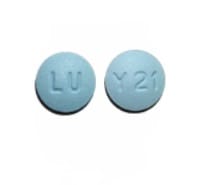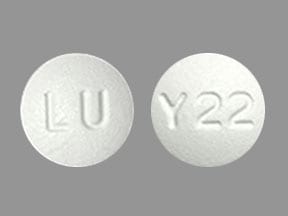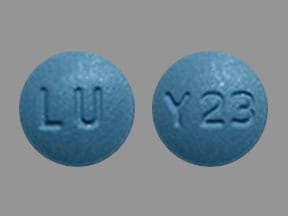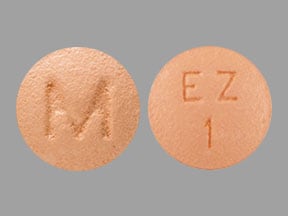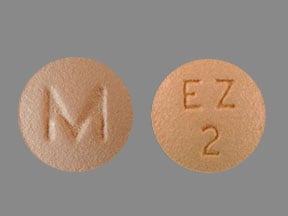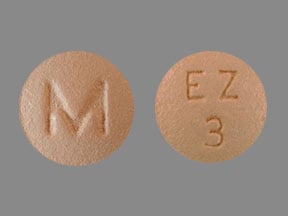Boxed Warning
Complex sleep behaviors:
Complex sleep behaviors, including sleep-walking, sleep-driving, and engaging in other activities while not fully awake, may occur following use of eszopiclone. Some of these events may result in serious injuries, including death. Discontinue eszopiclone immediately if a patient experiences a complex sleep behavior.
Dosage Forms
Excipient information presented when available (limited, particularly for generics); consult specific product labeling.
Tablet, Oral:
Lunesta: 1 mg [contains fd&c blue #2 (indigotine)]
Lunesta: 2 mg
Lunesta: 3 mg [contains fd&c blue #2 (indigotine)]
Generic: 1 mg, 2 mg, 3 mg
Pharmacology
Mechanism of Action
May interact with GABA-receptor complexes at binding domains located close to or allosterically coupled to benzodiazepine receptors.
Pharmacokinetics/Pharmacodynamics
Absorption
Rapid; high-fat/heavy meal may delay absorption
Metabolism
Hepatic via oxidation and demethylation (CYP2E1, 3A4); (S)-N-desmethyl zopiclone metabolite has less activity than parent compound
Excretion
Urine (up to 75%, primarily as metabolites; <10% as parent drug)
Time to Peak
~1 hour
Half-Life Elimination
~6 hours; Elderly (≥65 years): ~9 hours
Protein Binding
52% to 59%
Use in Specific Populations
Special Populations: Hepatic Function Impairment
Systemic exposure is doubled in severe hepatic impairment with no change in Cmax or Tmax.
Special Populations: Elderly
Subjects ≥65 years of age had a 41% increase in total exposure (AUC) and a 50% increase in elimination half-life.
Use: Labeled Indications
Insomnia: Treatment of insomnia
Contraindications
Hypersensitivity to eszopiclone or any component of the formulation; patients who have experienced complex sleep behaviors after taking eszopiclone.
Dosage and Administration
Dosing: Adult
Insomnia: Oral: Note: The lowest effective dose should be used.
Initial: 1 mg immediately before bedtime; dosing may be increased to 2 mg or 3 mg if clinically necessary (maximum dose: 3 mg daily)
Debilitated patients: Initial: 1 mg immediately before bedtime (maximum dose: 2 mg)
Concurrent use with strong CYP3A4 inhibitor: Initial: 1 mg immediately before bedtime (maximum dose: 2 mg)
Dosing: Geriatric
Avoid use (Beers Criteria [AGS 2019]).
Administration
Because of the rapid onset of action, eszopiclone should be administered immediately prior to bedtime or after the patient has gone to bed and is having difficulty falling asleep. Do not take with, or immediately following, a high-fat meal (may delay onset).
Dietary Considerations
Avoid taking after a heavy meal; may delay onset.
Storage
Store at 25°C (77°F); excursions permitted to 15°C to 30°C (59°F to 86°F).
Eszopiclone Images
Drug Interactions
Alcohol (Ethyl): CNS Depressants may enhance the CNS depressant effect of Alcohol (Ethyl). Monitor therapy
Alizapride: May enhance the CNS depressant effect of CNS Depressants. Monitor therapy
Aprepitant: May increase the serum concentration of CYP3A4 Substrates (High risk with Inhibitors). Monitor therapy
Azelastine (Nasal): CNS Depressants may enhance the CNS depressant effect of Azelastine (Nasal). Avoid combination
Blonanserin: CNS Depressants may enhance the CNS depressant effect of Blonanserin. Consider therapy modification
Bosentan: May decrease the serum concentration of CYP3A4 Substrates (High risk with Inducers). Monitor therapy
Brexanolone: CNS Depressants may enhance the CNS depressant effect of Brexanolone. Monitor therapy
Brimonidine (Topical): May enhance the CNS depressant effect of CNS Depressants. Monitor therapy
Bromopride: May enhance the CNS depressant effect of CNS Depressants. Monitor therapy
Bromperidol: May enhance the CNS depressant effect of CNS Depressants. Avoid combination
Buprenorphine: CNS Depressants may enhance the CNS depressant effect of Buprenorphine. Management: Consider reduced doses of other CNS depressants, and avoiding such drugs in patients at high risk of buprenorphine overuse/self-injection. Initiate buprenorphine at lower doses in patients already receiving CNS depressants. Consider therapy modification
Cannabidiol: May enhance the CNS depressant effect of CNS Depressants. Monitor therapy
Cannabis: May enhance the CNS depressant effect of CNS Depressants. Monitor therapy
Chlormethiazole: May enhance the CNS depressant effect of CNS Depressants. Management: Monitor closely for evidence of excessive CNS depression. The chlormethiazole labeling states that an appropriately reduced dose should be used if such a combination must be used. Consider therapy modification
Chlorphenesin Carbamate: May enhance the adverse/toxic effect of CNS Depressants. Monitor therapy
Clofazimine: May increase the serum concentration of CYP3A4 Substrates (High risk with Inhibitors). Monitor therapy
CNS Depressants: May enhance the adverse/toxic effect of other CNS Depressants. Monitor therapy
Conivaptan: May increase the serum concentration of CYP3A4 Substrates (High risk with Inhibitors). Avoid combination
CYP3A4 Inducers (Moderate): May decrease the serum concentration of CYP3A4 Substrates (High risk with Inducers). Monitor therapy
CYP3A4 Inducers (Strong): May increase the metabolism of CYP3A4 Substrates (High risk with Inducers). Management: Consider an alternative for one of the interacting drugs. Some combinations may be specifically contraindicated. Consult appropriate manufacturer labeling. Consider therapy modification
CYP3A4 Inhibitors (Moderate): May decrease the metabolism of CYP3A4 Substrates (High risk with Inhibitors). Monitor therapy
CYP3A4 Inhibitors (Strong): May increase the serum concentration of Eszopiclone. Management: Limit the eszopiclone dose to 2 mg daily when combined with strong CYP3A4 inhibitors and monitor for increased eszopiclone effects and toxicities (eg, somnolence, drowsiness, CNS depression). Consider therapy modification
Dabrafenib: May decrease the serum concentration of CYP3A4 Substrates (High risk with Inducers). Management: Seek alternatives to the CYP3A4 substrate when possible. If concomitant therapy cannot be avoided, monitor clinical effects of the substrate closely (particularly therapeutic effects). Consider therapy modification
Deferasirox: May decrease the serum concentration of CYP3A4 Substrates (High risk with Inducers). Monitor therapy
Dimethindene (Topical): May enhance the CNS depressant effect of CNS Depressants. Monitor therapy
Doxylamine: May enhance the CNS depressant effect of CNS Depressants. Management: The manufacturer of Diclegis (doxylamine/pyridoxine), intended for use in pregnancy, specifically states that use with other CNS depressants is not recommended. Monitor therapy
Dronabinol: May enhance the CNS depressant effect of CNS Depressants. Monitor therapy
Droperidol: May enhance the CNS depressant effect of CNS Depressants. Management: Consider dose reductions of droperidol or of other CNS agents (eg, opioids, barbiturates) with concomitant use. Exceptions to this monograph are discussed in further detail in separate drug interaction monographs. Consider therapy modification
Duvelisib: May increase the serum concentration of CYP3A4 Substrates (High risk with Inhibitors). Monitor therapy
Enzalutamide: May decrease the serum concentration of CYP3A4 Substrates (High risk with Inducers). Management: Concurrent use of enzalutamide with CYP3A4 substrates that have a narrow therapeutic index should be avoided. Use of enzalutamide and any other CYP3A4 substrate should be performed with caution and close monitoring. Consider therapy modification
Erdafitinib: May decrease the serum concentration of CYP3A4 Substrates (High risk with Inducers). Monitor therapy
Erdafitinib: May increase the serum concentration of CYP3A4 Substrates (High risk with Inhibitors). Monitor therapy
Esketamine: May enhance the CNS depressant effect of CNS Depressants. Monitor therapy
Flunitrazepam: CNS Depressants may enhance the CNS depressant effect of Flunitrazepam. Consider therapy modification
Fosaprepitant: May increase the serum concentration of CYP3A4 Substrates (High risk with Inhibitors). Monitor therapy
Fosnetupitant: May increase the serum concentration of CYP3A4 Substrates (High risk with Inhibitors). Monitor therapy
Fusidic Acid (Systemic): May increase the serum concentration of CYP3A4 Substrates (High risk with Inhibitors). Avoid combination
HYDROcodone: CNS Depressants may enhance the CNS depressant effect of HYDROcodone. Management: Avoid concomitant use of hydrocodone and benzodiazepines or other CNS depressants when possible. These agents should only be combined if alternative treatment options are inadequate. If combined, limit the dosages and duration of each drug. Consider therapy modification
HydrOXYzine: May enhance the CNS depressant effect of CNS Depressants. Monitor therapy
Idelalisib: May increase the serum concentration of CYP3A4 Substrates (High risk with Inhibitors). Avoid combination
Ivosidenib: May decrease the serum concentration of CYP3A4 Substrates (High risk with Inducers). Monitor therapy
Kava Kava: May enhance the adverse/toxic effect of CNS Depressants. Monitor therapy
Larotrectinib: May increase the serum concentration of CYP3A4 Substrates (High risk with Inhibitors). Monitor therapy
Lemborexant: May enhance the CNS depressant effect of CNS Depressants. Management: Dosage adjustments of lemborexant and of concomitant CNS depressants may be necessary when administered together because of potentially additive CNS depressant effects. Close monitoring for CNS depressant effects is necessary. Consider therapy modification
Lofexidine: May enhance the CNS depressant effect of CNS Depressants. Management: Drugs listed as exceptions to this monograph are discussed in further detail in separate drug interaction monographs. Monitor therapy
Lorlatinib: May decrease the serum concentration of CYP3A4 Substrates (High risk with Inducers). Management: Avoid concurrent use of lorlatinib with any CYP3A4 substrates for which a minimal decrease in serum concentrations of the CYP3A4 substrate could lead to therapeutic failure and serious clinical consequences. Consider therapy modification
Magnesium Sulfate: May enhance the CNS depressant effect of CNS Depressants. Monitor therapy
Melatonin: May enhance the sedative effect of Hypnotics (Nonbenzodiazepine). Monitor therapy
Methotrimeprazine: CNS Depressants may enhance the CNS depressant effect of Methotrimeprazine. Methotrimeprazine may enhance the CNS depressant effect of CNS Depressants. Management: Reduce adult dose of CNS depressant agents by 50% with initiation of concomitant methotrimeprazine therapy. Further CNS depressant dosage adjustments should be initiated only after clinically effective methotrimeprazine dose is established. Consider therapy modification
MetyroSINE: CNS Depressants may enhance the sedative effect of MetyroSINE. Monitor therapy
MiFEPRIStone: May increase the serum concentration of CYP3A4 Substrates (High risk with Inhibitors). Management: Minimize doses of CYP3A4 substrates, and monitor for increased concentrations/toxicity, during and 2 weeks following treatment with mifepristone. Avoid cyclosporine, dihydroergotamine, ergotamine, fentanyl, pimozide, quinidine, sirolimus, and tacrolimus. Consider therapy modification
Minocycline (Systemic): May enhance the CNS depressant effect of CNS Depressants. Monitor therapy
Mitotane: May decrease the serum concentration of CYP3A4 Substrates (High risk with Inducers). Management: Doses of CYP3A4 substrates may need to be adjusted substantially when used in patients being treated with mitotane. Consider therapy modification
Nabilone: May enhance the CNS depressant effect of CNS Depressants. Monitor therapy
Netupitant: May increase the serum concentration of CYP3A4 Substrates (High risk with Inhibitors). Monitor therapy
Opioid Agonists: CNS Depressants may enhance the CNS depressant effect of Opioid Agonists. Management: Avoid concomitant use of opioid agonists and benzodiazepines or other CNS depressants when possible. These agents should only be combined if alternative treatment options are inadequate. If combined, limit the dosages and duration of each drug. Consider therapy modification
Orphenadrine: CNS Depressants may enhance the CNS depressant effect of Orphenadrine. Avoid combination
Oxomemazine: May enhance the CNS depressant effect of CNS Depressants. Avoid combination
OxyCODONE: CNS Depressants may enhance the CNS depressant effect of OxyCODONE. Management: Avoid concomitant use of oxycodone and benzodiazepines or other CNS depressants when possible. These agents should only be combined if alternative treatment options are inadequate. If combined, limit the dosages and duration of each drug. Consider therapy modification
Palbociclib: May increase the serum concentration of CYP3A4 Substrates (High risk with Inhibitors). Monitor therapy
Paraldehyde: CNS Depressants may enhance the CNS depressant effect of Paraldehyde. Avoid combination
Perampanel: May enhance the CNS depressant effect of CNS Depressants. Management: Patients taking perampanel with any other drug that has CNS depressant activities should avoid complex and high-risk activities, particularly those such as driving that require alertness and coordination, until they have experience using the combination. Consider therapy modification
Piribedil: CNS Depressants may enhance the CNS depressant effect of Piribedil. Monitor therapy
Pramipexole: CNS Depressants may enhance the sedative effect of Pramipexole. Monitor therapy
ROPINIRole: CNS Depressants may enhance the sedative effect of ROPINIRole. Monitor therapy
Rotigotine: CNS Depressants may enhance the sedative effect of Rotigotine. Monitor therapy
Rufinamide: May enhance the adverse/toxic effect of CNS Depressants. Specifically, sleepiness and dizziness may be enhanced. Monitor therapy
Sarilumab: May decrease the serum concentration of CYP3A4 Substrates (High risk with Inducers). Monitor therapy
Selective Serotonin Reuptake Inhibitors: CNS Depressants may enhance the adverse/toxic effect of Selective Serotonin Reuptake Inhibitors. Specifically, the risk of psychomotor impairment may be enhanced. Monitor therapy
Siltuximab: May decrease the serum concentration of CYP3A4 Substrates (High risk with Inducers). Monitor therapy
Simeprevir: May increase the serum concentration of CYP3A4 Substrates (High risk with Inhibitors). Monitor therapy
Sodium Oxybate: Hypnotics (Nonbenzodiazepine) may enhance the CNS depressant effect of Sodium Oxybate. Avoid combination
Stiripentol: May increase the serum concentration of CYP3A4 Substrates (High risk with Inhibitors). Management: Use of stiripentol with CYP3A4 substrates that are considered to have a narrow therapeutic index should be avoided due to the increased risk for adverse effects and toxicity. Any CYP3A4 substrate used with stiripentol requires closer monitoring. Consider therapy modification
Suvorexant: CNS Depressants may enhance the CNS depressant effect of Suvorexant. Management: Dose reduction of suvorexant and/or any other CNS depressant may be necessary. Use of suvorexant with alcohol is not recommended, and the use of suvorexant with any other drug to treat insomnia is not recommended. Consider therapy modification
Tapentadol: May enhance the CNS depressant effect of CNS Depressants. Management: Avoid concomitant use of tapentadol and benzodiazepines or other CNS depressants when possible. These agents should only be combined if alternative treatment options are inadequate. If combined, limit the dosages and duration of each drug. Consider therapy modification
Tetrahydrocannabinol: May enhance the CNS depressant effect of CNS Depressants. Monitor therapy
Tetrahydrocannabinol and Cannabidiol: May enhance the CNS depressant effect of CNS Depressants. Monitor therapy
Thalidomide: CNS Depressants may enhance the CNS depressant effect of Thalidomide. Avoid combination
Tocilizumab: May decrease the serum concentration of CYP3A4 Substrates (High risk with Inducers). Monitor therapy
Trimeprazine: May enhance the CNS depressant effect of CNS Depressants. Monitor therapy
Zolpidem: CNS Depressants may enhance the CNS depressant effect of Zolpidem. Management: Reduce the Intermezzo brand sublingual zolpidem adult dose to 1.75 mg for men who are also receiving other CNS depressants. No such dose change is recommended for women. Avoid use with other CNS depressants at bedtime; avoid use with alcohol. Consider therapy modification
Adverse Reactions
>10%:
Central nervous system: Headache (15% to 21%)
Gastrointestinal: Dysgeusia (8% to 34%)
1% to 10%:
Cardiovascular: Chest pain (≥1%), peripheral edema (≥1%)
Central nervous system: Drowsiness (8% to 10%), dizziness (5% to 7%), pain (4% to 5%), nervousness (≤5%), depression (1% to 4%), confusion (≤3%), neuralgia (≤3%), abnormal dreams (1% to 3%), anxiety (1% to 3%), hallucination (1% to 3%), migraine
Dermatologic: Skin rash (3% to 4%), pruritus (1% to 4%)
Endocrine & metabolic: Decreased libido (≤3%), gynecomastia (≤3%)
Gastrointestinal: Xerostomia (3% to 7%), dyspepsia (2% to 6%), nausea (4% to 5%), diarrhea (2% to 4%), vomiting (≤3%)
Genitourinary: Dysmenorrhea (≤3%), urinary tract infection (≤3%)
Infection: Infection (5% to 10%), viral infection (3%)
Miscellaneous: Accidental injury (≤3%)
<1%, postmarketing, and/or case reports: Abnormal gait, abnormality in thinking, agitation, alopecia, altered sense of smell, amenorrhea, anaphylaxis, anemia, angioedema, anorexia, apathy, aphthous stomatitis, arthritis, asthma, ataxia, blepharoptosis, breast hypertrophy, breast neoplasm, bronchitis, bursitis, cholelithiasis, colitis, complex sleep-related disorder, conjunctivitis, contact dermatitis, cystitis, dehydration, diaphoresis, dry eye syndrome, dysphagia, dyspnea, dysuria, eczema, emotional lability, epistaxis, erythema multiforme, euphoria, facial edema, fever, gastric ulcer, gastritis, gout, halitosis, heatstroke, heavy menstrual bleeding, hematuria, hepatic disease, hepatitis, hepatomegaly, herpes zoster infection, hirsutism, hostility, hypercholesterolemia, hypersensitivity reaction, hypertension, hypokalemia, hyporeflexia, increased appetite, increased thirst, insomnia, laryngitis, lymphadenopathy, maculopapular rash, malaise, mastalgia, mastitis, melena, memory impairment, myasthenia, mydriasis, myopathy, neck stiffness, nephrolithiasis, neuritis, neuropathy, neurosis, nystagmus disorder, oliguria, paresthesia, photophobia, pyelonephritis, rectal hemorrhage, renal pain, skin discoloration, skin photosensitivity, swelling, thrombophlebitis, tinnitus, tongue edema, tremor, twitching, urethritis, urinary frequency, urinary incontinence, urticaria, uterine hemorrhage, vaginal hemorrhage, vaginitis, vertigo, vesiculobullous dermatitis, vestibular disturbance
Warnings/Precautions
Concerns related to adverse effects:
- Abnormal thinking/behavioral changes: Hypnotics/sedatives have been associated with abnormal thinking and behavior changes, including decreased inhibition, aggression, bizarre behavior, agitation, hallucinations, and depersonalization. Amnesia and other neuropsychiatric symptoms may occur unpredictably and may indicate previously unrecognized psychiatric disorders; evaluate appropriately.
- CNS depression: Daytime function may be impaired in patients taking higher doses (2 or 3 mg), even if used as prescribed; caution patients taking 3 mg about performing tasks that require mental alertness (eg, operating machinery, driving) the day after use. The risk of next-day psychomotor impairment is increased if taken with less than a full night of sleep (7 to 8 hours); if a higher than recommended dose is taken; or if coadministered with other CNS depressants or other drugs that increase blood concentrations of eszopiclone. Dose adjustment may be necessary if taking concomitant CNS depressants; the use of concomitant sedative-hypnotics at bedtime or in the middle of the night is not recommended.
- Complex sleep behaviors: [US Boxed Warning]: Complex sleep behaviors, including sleep-walking, sleep-driving, and engaging in other activities while not fully awake, may occur following the use of eszopiclone. Some of these events may result in serious injuries, including death. Other complex sleep behaviors (eg, preparing and eating food, making phone calls, having sex) while asleep have also been reported. Patients usually do not remember these events. May occur with first use and at recommended dosages with or without the use of alcohol or other CNS depressants. Discontinue immediately if a patient experiences a complex sleep behavior; use is contraindicated in patients who have experienced these events.
- Hypersensitivity reactions: Hypersensitivity reactions including anaphylaxis as well as angioedema have been reported, in some cases following initial dosing. Patients who develop severe reactions should not be rechallenged.
Disease-related concerns:
- Depression: Use with caution in patients with depression; worsening of depression, including suicidal ideation has been reported with the use of hypnotics. Intentional overdose may be an issue in this population. The minimum dose that will effectively treat the individual patient should be used. Prescriptions should be written for the smallest quantity consistent with good patient care.
- Drug abuse: Use with caution in patients with a history of drug dependence.
- Hepatic impairment: Use with caution in patients with hepatic impairment; dosage adjustment required with severe impairment.
- Respiratory disease: Use with caution in patients with respiratory compromise, COPD or sleep apnea.
Concurrent drug therapy issues:
- Drug-drug interactions: Potentially significant interactions may exist, requiring dose or frequency adjustment, additional monitoring, and/or selection of alternative therapy. Consult drug interactions database for more detailed information.
Special populations:
- Debilitated: Use with caution in debilitated patients; increased risk of impaired cognitive and/or motor performance. Dose adjustment recommended; monitor closely.
- Elderly: Increased risk of impaired cognitive and/or motor performance and falls; monitor closely.
Other warnings/precautions:
- Appropriate use: Symptomatic treatment of insomnia should be initiated only after careful evaluation of potential causes of sleep disturbance. Failure of sleep disturbance to resolve after 7-10 days may indicate psychiatric and/or medical illness.
- Duration of therapy: Tolerance, as assessed by sleep measurement, did not develop over 6 months of use.
- Rapid onset: Because of the rapid onset of action, administer immediately prior to bedtime or after the patient has gone to bed and is having difficulty falling asleep.
- Withdrawal: Abrupt discontinuance or rapid dose decreases may lead to withdrawal symptoms.
Pregnancy
Pregnancy Considerations
Eszopiclone is the S-isomer of the racemic derivative zopiclone. Available data related to zopiclone (not available in the United States) and similar medications note the potential for preterm birth, low birth weight, and/or small for gestational age infants following maternal use.
Long-term use of medications in this class is not recommended during pregnancy and a planned discontinuation should be done to prevent rebound insomnia (Okun 2015).
Patient Education
What is this drug used for?
- It is used to treat sleep problems.
Frequently reported side effects of this drug
- Bad taste
- Dry mouth
- Headache
- Anxiety
- Dizziness
- Common cold symptoms
- Day fatigue
Other side effects of this drug: Talk with your doctor right away if you have any of these signs of:
- Depression like thoughts of suicide, anxiety, emotional instability, or confusion.
- Behavioral changes
- Sensing things that seem real but are not
- Trouble with memory
- Change in balance
- Confusion
- Severe loss of strength and energy
- Chills
- Sore throat
- Vomiting
- Severe nausea
- Signs of a significant reaction like wheezing; chest tightness; fever; itching; bad cough; blue skin color; seizures; or swelling of face, lips, tongue, or throat.
Note: This is not a comprehensive list of all side effects. Talk to your doctor if you have questions.
Consumer Information Use and Disclaimer: This information should not be used to decide whether or not to take this medicine or any other medicine. Only the healthcare provider has the knowledge and training to decide which medicines are right for a specific patient. This information does not endorse any medicine as safe, effective, or approved for treating any patient or health condition. This is only a brief summary of general information about this medicine. It does NOT include all information about the possible uses, directions, warnings, precautions, interactions, adverse effects, or risks that may apply to this medicine. This information is not specific medical advice and does not replace information you receive from the healthcare provider. You must talk with the healthcare provider for complete information about the risks and benefits of using this medicine.
